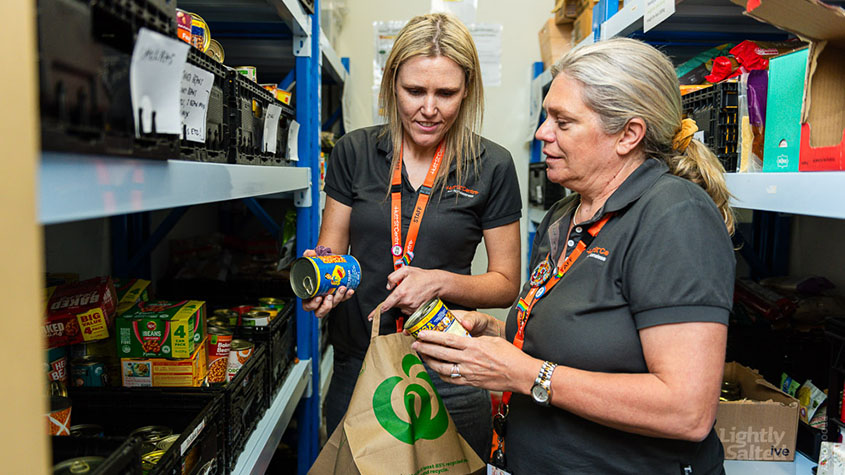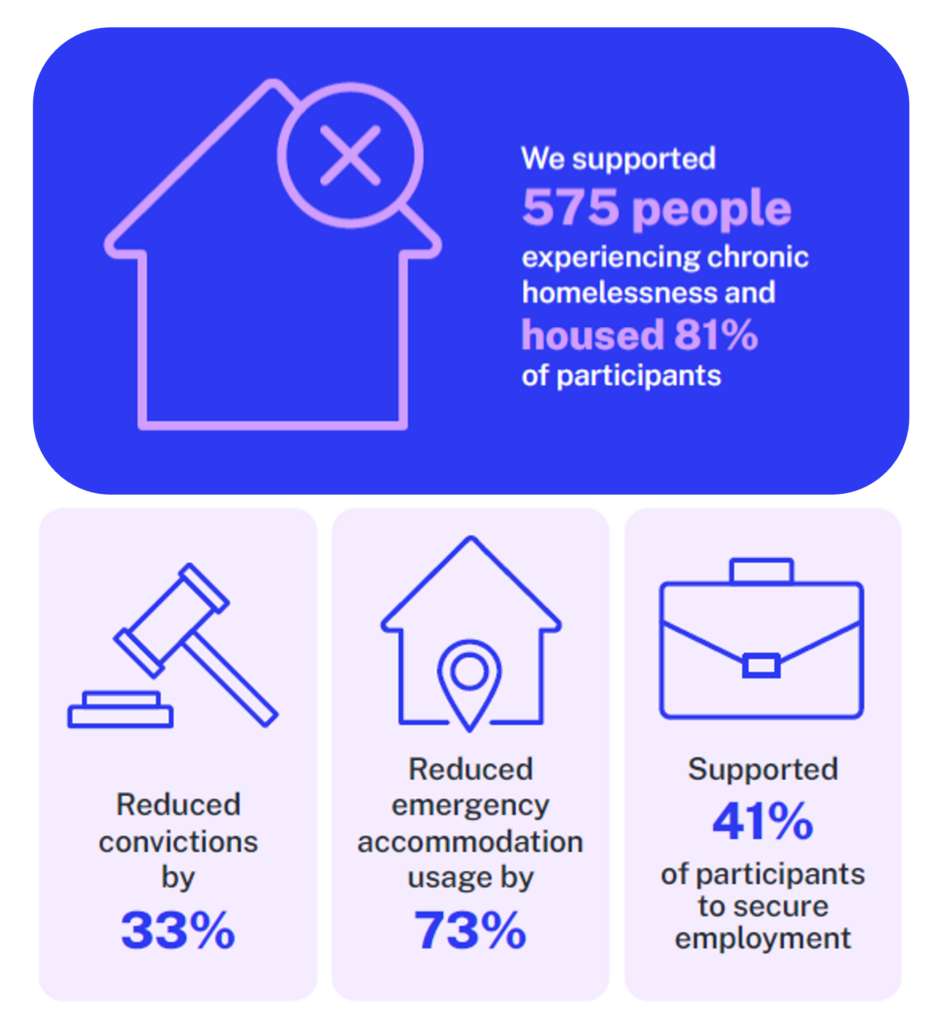A proven solution for countering chronic homelessness, Aspire will live on beyond the SIB
SVA’s second social impact bond has successfully matured making a lasting difference in the lives of people experiencing chronic homelessness. The Aspire SIB has delivered savings for the South Australian Government, achieved excellent results as an innovative social finance model, and the program is receiving ongoing funding directly from the South Australian Government.

As Australia’s first homelessness-focused social impact bond, and the first social impact bond in South Australia, the Aspire SIB has proven successful by all standards. It has had a significant positive impact for people experiencing chronic homelessness.
My experience with Aspire was better than I could have ever dreamed of. It has completely changed my life and given me a bright positive future… My experience with my case navigation was amazing from sleeping rough in the beginning, to three years later and having long-term housing and full-time employment.”Aspire participant
At the same time, the Aspire SIB is estimated to have delivered savings to the South Australian (SA) Government by reducing the cost of crisis services by over $40 million.
Beyond cost savings and significantly improved tenancy retention rates, Aspire has profoundly impacted lives, helping men and women reconnect with communities and rebuild their lives.”Chris Burns • Chief Executive Officer of Hutt St Centre which delivered the Aspire program
The Aspire program is a Housing First intensive case management program that works with participants for three years.
A specialist homelessness service provider based in Adelaide, Hutt St Centre started delivering the Aspire program in partnership with public and community housing providers in 2017. They saw it as an enhancement of Hutt St Centre’s existing programs, whilst addressing a clear gap in the homelessness service system.
The Aspire SIB funded the Aspire program over 7.75 years using $9 million of investor capital. See investor report.
Results
Over the term of the SIB funding arrangement, the Aspire program supported 575 people experiencing chronic homelessness. 81% of participants were housed, with 85% maintaining their tenancies.
The positive housing outcomes achieved for Aspire participants are similar to other successful Housing First programs, including the Journey to Social Inclusion program which had 90% of participants in stable housing three or four years after commencing the program.
Critically, Aspire participants experienced a significant reduction in the rates at which they accessed hospital, justice and emergency accommodation services, in comparison to the baselines against which program results are measured – by 29%, 33% and 73% respectively. And 41% of participants were supported into secure employment.

These measured reductions were significantly larger than expected, and as a result, the Aspire SIB has delivered a financial return to investors of 14.1% per annum. Investor courage in backing the Aspire SIB in 2017 has paid off; at the time there was limited evidence in Australia supporting housing first models like Aspire and investors could have lost around 50% of their investment if the SIB underperformed and was terminated early.
The success of the Aspire program under the SIB has proven the effectiveness of the program in reducing the use of health, justice and homelessness services by people experiencing chronic homelessness in Adelaide. These results add to the evidence base supporting housing first models and what works for ending homelessness.
As a result, the Aspire program is recognised as an integral component of the broader homelessness service system with the SA Government continuing to fund it. The follow-on contract will enable Hutt St Centre to enrol new participants until mid-2027. It will maintain the robust outcome measurement approach used by the Aspire SIB.
The Aspire SIB has influenced the design of SVA’s latest social impact bond, the Arc SIB, which aims to break the cycle of homelessness and reoffending in Victoria.
Insights from the Aspire SIB
The Hutt St Centre, the SA Government and SVA share some of our collective reflections on the journey as well as key findings from the evaluation carried out in 2022.
- Aspire provides a unique offering for people experiencing chronic homelessness in Adelaide
The Aspire SIB evaluation highlighted that three fundamental – and quite straightforward – factors underpin the success of the Aspire program: the capacity to help individuals secure and maintain permanent housing; provision of up to three years of case management support; and low caseloads enabling case managers to dedicate considerable time to building trust and tailoring support for each individual.
Aspire has caseloads of around 1 to 15 participants, whereas other case management programs in South Australia are typically funded to provide only three to six months of support with higher caseloads of one to 25 (or more) participant.
- The program achieved positive outcomes despite housing supply being a pervasive challenge for the duration of the SIB
It was expected that community housing providers would be able to house all participants within 30 days of referral to Aspire, however, securing sufficient and appropriate housing for Aspire participants remained a challenge throughout the program.
The median time to house Aspire participants was 4 months, with an average of almost 7 months. In the interim, the intensive case management supports offered by Aspire were able to assist clients to find temporary housing options and work with them on other needs and goals.
Community housing providers collectively provided around 29% of properties, with the SA Housing Trust providing around 69% of properties – which was much higher than anticipated. 2% were able to secure housing in the private rental market.
For the Aspire model to be replicable and successful, there needs to be deliberate consideration given to how pervasive housing challenges would be addressed, whether that be investment in more social housing, top-up funding for accessing private rentals, prioritisation on social housing waitlists or other levers to increasing housing supply for this cohort.
- The Aspire SIB opened the door to broader use of data by SA Government and Hutt St Centre
The Aspire SIB involved setting up appropriate data sharing arrangements between three SA Government agencies: SA Health, the SA Courts Administration Authority and the SA Housing Trust. This has helped refine data infrastructure which can be leveraged for future projects.
Key learnings from Aspire included allowing for lags in convictions data and putting in place contractual safeguards to ensure that the baseline that program performance is assessed against fairly reflects the complexity and characteristics of the individuals entering the program.
Although the Aspire SIB outcomes data has not directly informed service adaptations by Hutt St Centre, the broader Aspire SIB governance and reporting arrangements have driven additional collection of data used for ongoing monitoring and service improvement.
- There remain barriers to embedding successful pilots such as Aspire in the policy and service landscape
There is growing evidence of the success and government savings from Housing First approaches for people experiencing chronic homelessness. However, there are several barriers to governments funding, and the sector adopting, this model more broadly across Australia. See Quarterly article: Housing First: the challenges of moving from pilot to policy for more insights on this.
About the Aspire SIB including the Aspire SIB evaluation and recent investor report.





